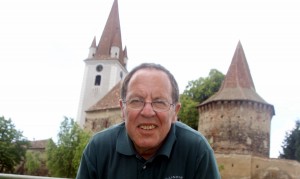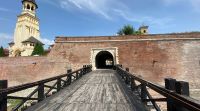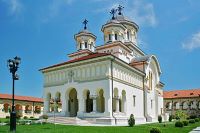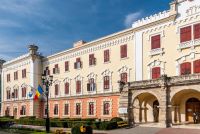
Sibiu, Romania —
Anyone who knows my fascination with forts, old Cathedrals, and museums (that is, anyone who has ever traveled with me), can well imagine the joy-filled day I’m about to share that consisted of forts, old Cathedrals (sometimes one with the forts), and museums–along with the beautiful scenery of the Transylvania countryside. That may be familiar to you as the “home” of Dracula, an idealization of the famous Vlad Terpres, Vlad the Impaler (and for tonight, the home of Fred; the only bloodthirsty anythings around are the mosquitoes, teased out by the rain and now warm weather).
Let me start with none of the above joys–or at least a different one for Romania, the countryside. I believe the country has one of the largest percentages of farmers in Europe; a look at the basics of agriculture kind of explains why. There’s still a lot of horsepower supplied by horses. I saw a man with a scythe, honing it by hand; I saw people in the fields with hoes. That doesn’t happen in Illinois, except maybe around Arthur, or in backyards. The infrastructure is abuilding, which is to say it’s not yet built.
Traveling down from Baia Mare through Cluj-Napoca, which is the major university city, to Alba Iulia, which has historic importance in modern Romania (it’s where the country declared its independence), to Sibiu, the roads were mostly two-lane (which drivers tried to make three or four; sometimes on hills it actually was three lanes wide), with enough traffic for four lanes. My guide yesterday called the roads “Romanian Roads,” as in it’s only 180 miles but it will take you four hours; my driver today spoke no English, so we had a rather quiet ride. There were a lot of abandoned big plants, as I had been warned; the factories that employed thousands in inefficient industries have not been able to withstand global competition, or even EU competition. Some companies have located here, partly because of cheap labor. We saw a major Nokia factory, for example. The countryside was rolling after we climbed down from the Maramures district. The villages we went through had colorful homes and colorful churches, reflecting the history of this region, which has been a borderland and battle land from Roman times until recently.
The church at Cristian is a case in point; it’s aptly named for the 86% of the population that is orthodox, but has Hungarian and German names, reflecting the efforts of local rulers to populate the area and hold it against (choose at least one) the Tartars, Turks, Germans, Russians, Swedes, etc. It looks like a church, and it is a fort, but it’s also a castle (a fortified church). Fred gets two for one on this town, which is also the stork capital of the world–self-proclaimed.
We sailed through Cluj-Napoca, whose Romanian residents added the Napoca to emphasize their descent from the Romans, rather than the Magyars, who had ruled the area in the 18th and 19th centuries. Too bad, because from what I saw, it had a lot of forts, neat churches, and museums–and an Opera House that was performing Orpheus in the Underworld this weekend!
Our major stop was at Alba Iulia. As I mentioned, the industrial city has a special place in Romanian history since it was here that Transylvania became part of Romania twice–in 1599 for a brief union under Michael the Brave (which did not last beyond his assassination shortly thereafter) and on December 1, 1918, which is the date Romania celebrates as independence day (there’s a Boulevard December 1 in most cities). The city has been  important since Roman times, but the fort (or should I say, THE fort) is from the 18th century. Built along the lines pioneered by the famous French fort architect, Vauban, it’s a classic. The piece de resistance, however, is that it’s decorated in the inside in Baroque.
important since Roman times, but the fort (or should I say, THE fort) is from the 18th century. Built along the lines pioneered by the famous French fort architect, Vauban, it’s a classic. The piece de resistance, however, is that it’s decorated in the inside in Baroque.
If that were not enough to endear me to the place, my initial view was of one  of the most spectacular Orthodox churches I’ve seen. Called the Church of the Coronation, it was built in the early 1920s for the coronation of King Ferdinand I and Queen Marie (the latter is one of Romania’s best-loved politicians). It’s quite attractive, and resembles as much a monastery palace as a church. Ferdinand, a Catholic, refused to be coronated in an Orthodox Church, so the coronation was on the grounds.
of the most spectacular Orthodox churches I’ve seen. Called the Church of the Coronation, it was built in the early 1920s for the coronation of King Ferdinand I and Queen Marie (the latter is one of Romania’s best-loved politicians). It’s quite attractive, and resembles as much a monastery palace as a church. Ferdinand, a Catholic, refused to be coronated in an Orthodox Church, so the coronation was on the grounds.
 And if that weren’t enough, an 1851 building houses one of the best history museums in Romania. There were a lot of Roman sculptures, tombstones, pillars, etc., found in the area; as I said, the Romanians treasure, literally, their Roman heritage, and a nice display on three peasants who led an uprising in the 1780s (against the Hapsburgs, I believe). Two were crushed with a wheel (a wheely bad way to go)! Happily, most of the captions were in Romanian (and there were hordes of school children in the building), or I might still be looking at the items.
And if that weren’t enough, an 1851 building houses one of the best history museums in Romania. There were a lot of Roman sculptures, tombstones, pillars, etc., found in the area; as I said, the Romanians treasure, literally, their Roman heritage, and a nice display on three peasants who led an uprising in the 1780s (against the Hapsburgs, I believe). Two were crushed with a wheel (a wheely bad way to go)! Happily, most of the captions were in Romanian (and there were hordes of school children in the building), or I might still be looking at the items.
I was a happy camper when we wheeled (ha) into the Hilton in Sibiu. I’m here only one night, but it’s the poshest hotel I’ve stayed at. I’ve been able to swim in a lap pool, and used the sauna for a bit as well.
Tomorrow I have a tour of the city of Sibiu, which looks interesting, and a meeting in the afternoon with some English-speaking Scouts. I’m looking forward to that.